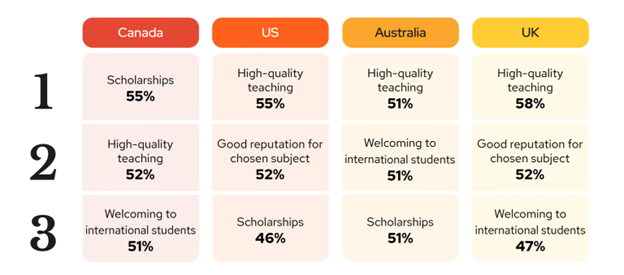
In today’s increasingly globalised education market, the factors motivating students to pursue their studies abroad are diverse. For universities to effectively shape their recruitment strategies, understanding what drives prospective international students to consider a country to study in is essential.
Using QS International Student Survey 2024 data, we have collated the top factors prospective students consider when selecting a university in leading study destinations: Canada, the US, Australia and the UK.
As the largest survey of its kind, the Survey highlights the motivations and decision-making of students across the globe.
Competition for international students is fierce. To stand out and create a compelling value proposition, universities need to tailor their approaches to resonate with what truly matters to students looking to study in their country, enhancing their appeal and competitive edge in international higher education.
What are the top choices for prospective international students looking to study abroad?

High-quality teaching is a universal priority, appearing in the top three motivators for all four countries.
Scholarships are a key factor in three of the four countries, highlighting the financial considerations that play a critical role in students’ decisions. Interestingly, Canada uniquely prioritises scholarships as the top motivator, whereas other countries place a higher emphasis on teaching quality.
For prospective students choosing the US and UK, there is a significant importance on the good reputation of institutions for specific subjects, reflecting their extensive offerings in specialised fields. Notably, students interested in Australia place near-equal importance on teaching quality, a welcoming environment, and scholarships.
Overall, the varied motivations across these destinations emphasise that a one-size-fits-all approach is ineffective in international student recruitment. Each country’s institutions must tailor their strategies to align with the specific needs and priorities of prospective students. Understanding these nuances allows universities to better market their strengths and address potential gaps.
Recommendations for universities in the big four study locations
Enhanced financial support
Canada should continue to leverage its strong scholarship offerings but also highlight teaching quality and inclusivity. Institutions in the US and UK, however, might focus on increasing financial aid options to attract a broader range of students.
Targeted content
Use digital platforms to create and share content that highlights scholarship opportunities, success stories, and financial aid guidance tailored to the interests and needs of students from specific regions.
Promote academic excellence and career specialisation
Given the importance of a good subject-specific reputation, universities must emphasise strong performance evidence high teaching standards. For example, highlighting unique programmes and cutting-edge research in your marketing efforts can make the difference in attracting academically driven students.
Cultivate a welcoming environment
Australia and Canada should continue to build on their reputations as welcoming destinations by offering robust support services for international students. This recommendation is particularly pertinent in light of recent international student policy changes in Australia and the UK’s recent decline in travel safety reputation.
Given the recent presidential election in the US, and our finding that many students would have favoured a Democrat win, universities in the US could consider focusing on promoting a welcoming on-campus environment, and celebrate the value of international diversity.
Balanced marketing approaches
Whether a student is looking to study in the US, Canada, Australia or the UK, their preferences do differ. However, lots of factors are cited – and there truly is no one size fits all approach. While the big factors like affordability, reputation, safety and a welcoming environment should absolutely be key messages as part of your marketing matrix, universities also must tell their own story. Consider what makes your university unique, and why students choose your university over others in the region.
By not being reliant on a single aspect alone, universities should create a more comprehensive appeal that addresses multiple facets of a student’s decision-making process.



